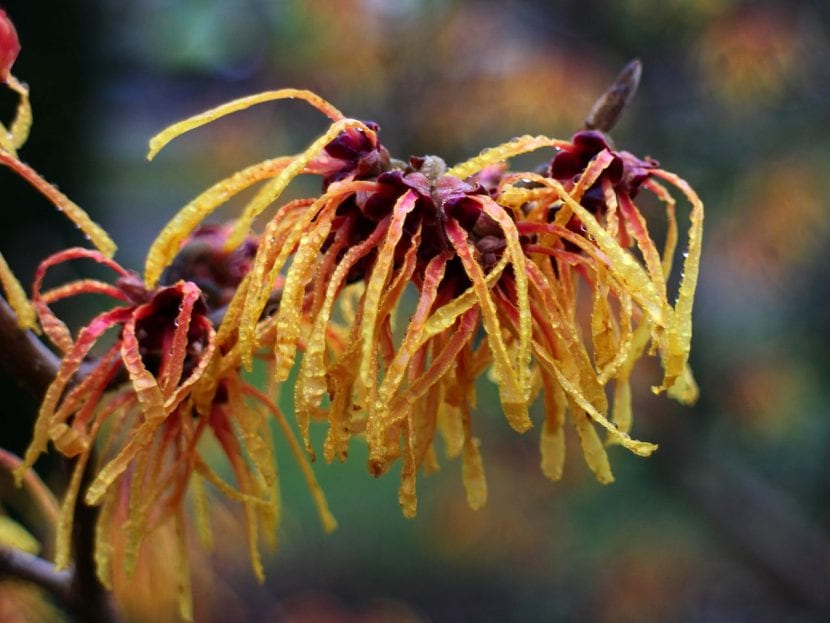
intermediate h.
Shrubs belonging to the genus hamamelis They are one of the most suitable to have in the gardens, whatever style they are. They are very beautiful throughout the year, but especially in spring and autumn. During the most colorful season of the year, curious very happy flowers sprout from them, and at the end of summer, when temperatures drop, their leaves turn red or a very interesting yellow color.
They are so beautiful and adaptable plants that they can even be had in pots since they tolerate pruning quite well.. And, as if that weren't enough, they have many uses apart from ornamental ones 😉.
Characteristics of witch hazel

Witch hazel plant during the fall.
Our protagonists they are shrubs or small deciduous trees 3 to 8 meters high originating in North America and Asia, specifically Japan and China. They are known by the common names Magic Hazel, Witch Hazel, Witches' Walnut. The genus consists of four species, which are the H. japonica, H. mollis, H. vernalis y H. virginiana. They are characterized by having alternate, oval leaves, up to 16cm long by 11cm wide, with wavy or smooth margins.
The flowers begin to bloom in late winter, and are at their peak in early spring. They are scented. They are made up of four thin petals that are pale yellow, dark orange, or red. Once they are pollinated, the fruit begins to ripen, which is a divided capsule that contains a single black seed.
How are they cared for?
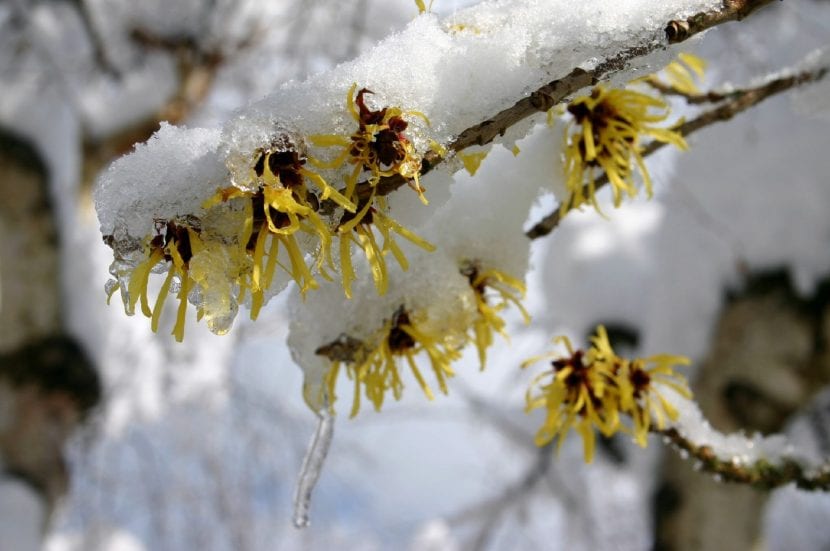
If you want to have one or more copies, then we will tell you how they are cared for:
Location
To be able to grow and develop well it is necessary that they be located in an area protected from direct sun, abroad.
Irrigation
The frequency of watering should be frequent, especially during the hottest season. Thus, it is highly recommended to keep the substrate or soil always fresh and humid, but avoiding waterlogging. In the event that you have a plate under them, you must remove the excess water ten minutes after watering to prevent the roots from suffocating.
It is important to use lime-free water, since otherwise the plants would have chlorosis caused by the lack of iron or magnesium. If it does appear, it can be treated with iron sulfate or by fertilizing with an acidic plant compost.
Subscriber
From spring to late summer (you can even do it in fall if you live in an area with mild winters) you must pay them with fertilizers such as guano (If you have them in a pot, use the one that comes in liquid form) or manure. You can also fertilize them with Nitrofoska, which is the fertilizer for blue grains, following the instructions specified on the package.
Substrate or soil
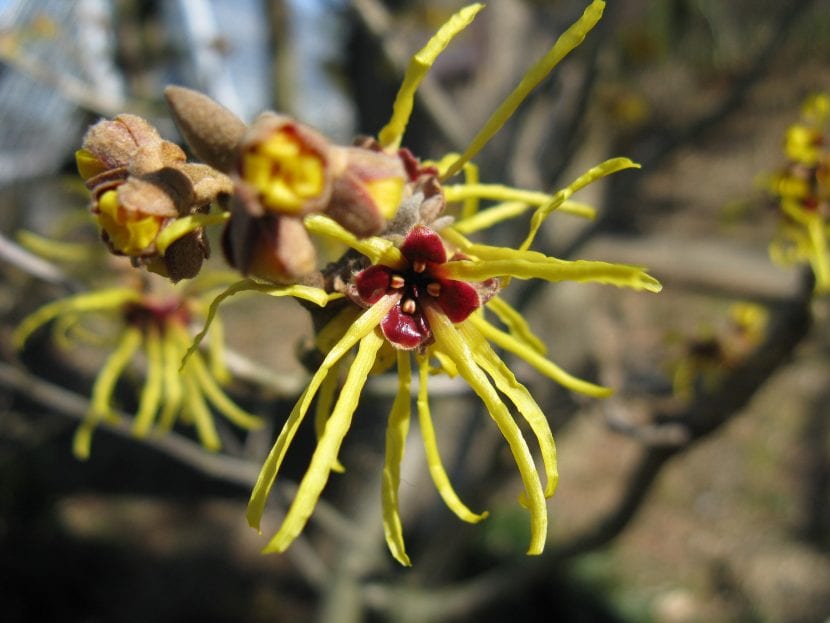
H. japonica
To be able to grow need acid soils, with a pH between 4 and 6, rich in organic matter, deep and fresh. If they are potted, they should use acidic plant substrates. You can also mix 70% akadama with 30% kyriuzuna, which will be ideal if you live in an area where summers are very hot (temperatures over 30ºC).
Planting or transplanting time
The best time to definitely plant it in the garden or to change it pot is in spring, at the end of flowering and only if it is not fruiting. If you see that the fruits are ripening, wait for them to dry out and transplant in autumn.
Plagues and diseases
The Hamamelis they are very resistant. You just have to prevent them from aphids spraying them with neem oil in summer.
Pruning
Can be pruned mid spring if necessary and they are not blooming.
Multiplication
To obtain new specimens you must sow their seeds as soon as you collect or acquire them, following this step by step:
- Soak them for a week, changing the water every day.
- After that time, sow them in a pot, seedling tray, milk containers, or in the seedbed you have at home, filling it with substrate for acidic plants.
- Cover the seeds with a thin layer of substrate, and put the seedling outside protected from direct sun.
- Keep the substrate moist (but not watery).
The first ones will germinate after two months.
What uses do they have?
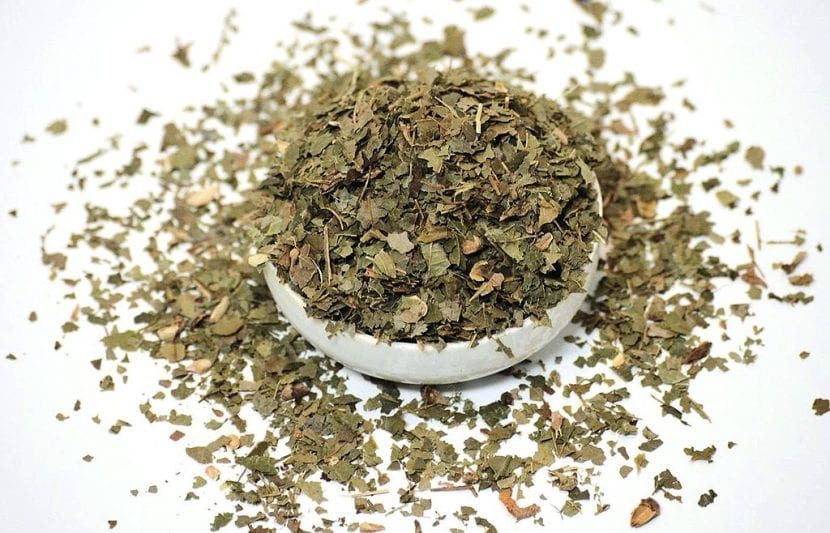
Witch hazel has several uses:
- Ornamental: as individual specimens or in groups, or to create fantastic hedges. Also, the flowers can be cut and kept in a vase.
- Medicinal: It is astringent, and the extract is used in lotions against insect bites. They are also used for ointments against hemorrhoids and eye drops to revitalize and rehydrate tired eyes, something that comes in handy when you work a lot with the computer (I tell you from experience 😉). It is very effective as a healing treatment for burns, as well as to reduce the signs of menopause.
Side effects and contraindications
The only negative about these plants is that their tannins can irritate the gastric mucosa, but this can be alleviated by mixing them for example with marshmallow. What's more, They should not be used in the case of gastritis or gastroduodental ulcer, nor should they be dosed with alcoholic content in children or people with alcohol problems.
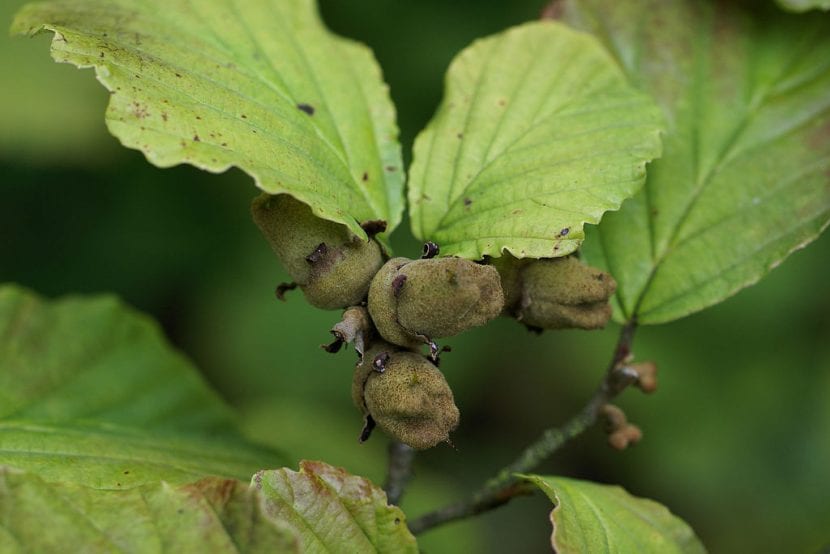
Witch hazel are great plants, don't you think?